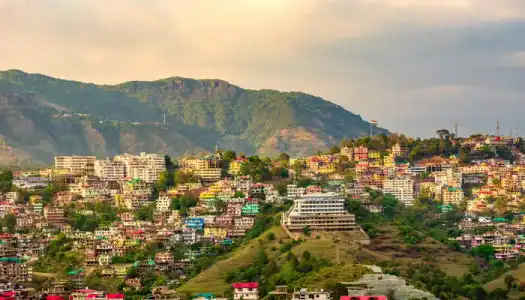Comprehensive Guide to Solan District
Introduction
Located in the picturesque state of Himachal Pradesh, the Solan District is a treasure trove of natural beauty, rich history, diverse cultures, and vibrant traditions. Known as the "Mushroom City of India" due to its extensive mushroom farming, Solan is also famed for its scenic landscapes, pleasant climate, and cultural heritage. This guide delves into the various facets of Solan, offering a detailed exploration of its geography, demography, history, culture, cuisine, notable personalities, and administration.
Geography of Solan
Solan District, spread across an area of 1936 square kilometers, is nestled in the lower Shivalik ranges of the Himalayas. The district is bounded by Shimla in the north, Sirmaur in the south, Bilaspur in the west, and the state of Haryana in the southeast. The terrain is a mix of high mountains, valleys, and meadows, making it a paradise for nature lovers and adventure enthusiasts.
Climate and Topography
Solan enjoys a moderate climate, with cool summers and mild winters, making it an ideal year-round destination. The altitude ranges from 300 meters to 3000 meters above sea level, providing a diverse topography that supports various flora and fauna. The district receives an average annual rainfall of about 1200 mm, primarily during the monsoon season from June to September.
Demography of Solan
Population
According to the 2011 Census, Solan has a population of approximately 576,670, with a balanced gender ratio. The district exhibits a mix of urban and rural populations, with major urban centers being Solan city, Baddi, Nalagarh, and Parwanoo.
Languages
The predominant language spoken is Hindi, with Pahari and Punjabi also widely used. English is understood and spoken in urban areas and among the educated populace.
Cultural Heritage
Festivals and Traditions
Solan's culture is a vibrant tapestry woven with numerous festivals, fairs, and traditional practices. Key festivals include Dussehra, Diwali, Holi, and the local Shoolini Fair, celebrated with much enthusiasm. The Shoolini Fair, dedicated to the goddess Shoolini Devi, is a significant event attracting visitors from across the state.
Arts and Crafts
The district is known for its exquisite handicrafts, including woodwork, metalwork, and embroidery. Traditional Himachali attire, adorned with intricate designs, is a highlight of Solan's cultural identity.
Cuisine of Solan
Solan's cuisine reflects its diverse cultural influences, blending traditional Himachali flavors with Punjabi and Tibetan culinary styles. Some popular dishes include:
- Siddu: A steamed bread made from wheat flour, often stuffed with a savory filling.
- Dham: A festive meal served during celebrations, consisting of rice, dal, rajma, and sweet dishes.
- Chana Madra: A chickpea curry cooked in yogurt and spices.
- Tibetan Momos: Steamed dumplings filled with vegetables or meat, a popular street food.
Historical Significance
Early History
Solan has a rich historical background, with its roots tracing back to ancient times. The region has been mentioned in various historical texts and has seen the rule of several dynasties, including the Mauryas, Guptas, and Rajputs.
Colonial Era
During the British colonial period, Solan gained prominence as a summer retreat. The British influence is still evident in the architecture and layout of Solan city, with several colonial-era buildings and churches dotting the landscape.
Notable Personalities
Yashwant Singh Parmar
Dr. Yashwant Singh Parmar, the first Chief Minister of Himachal Pradesh, hailed from Solan. He played a crucial role in the formation of the state and is remembered for his contributions to its development.
Dr. Manmohan Singh
Former Prime Minister Dr. Manmohan Singh has a significant connection to Solan, having spent part of his academic career at Solan's prestigious institutions.
Administrative Structure
Governance
Solan district is administratively divided into five sub-divisions: Solan, Nalagarh, Arki, Kandaghat, and Kasauli. Each sub-division is further divided into tehsils and development blocks for efficient governance.
Infrastructure
The district boasts well-developed infrastructure, with a network of roads, railways, and healthcare facilities. Solan is connected by the Kalka-Shimla railway, a UNESCO World Heritage Site, enhancing its accessibility.
Tourist Attractions
Solan City
Solan city, the district headquarters, is a bustling urban center known for its serene monasteries, beautiful parks, and historic sites. The Mohan Shakti National Heritage Park and the Shoolini Mata Temple are key attractions.
Kasauli
Kasauli, a charming hill station in Solan, offers breathtaking views, colonial-era architecture, and tranquil surroundings. The Christ Church, Monkey Point, and Gilbert Trail are must-visit spots.
Chail
Famous for its lush forests and the world's highest cricket ground, Chail is a haven for nature lovers and adventure seekers.
Barog
A quaint town known for its scenic beauty and the Barog Tunnel, one of the longest tunnels on the Kalka-Shimla railway line.
Conclusion
Solan district, with its harmonious blend of natural beauty, rich cultural heritage, and modern amenities, stands as a testament to the diversity and charm of Himachal Pradesh. Whether it's the allure of its scenic landscapes, the vibrancy of its festivals, or the warmth of its people, Solan offers a unique experience that leaves an indelible mark on every visitor. Explore Solan to discover the heart of Himachal Pradesh, where tradition meets modernity in perfect harmony.
